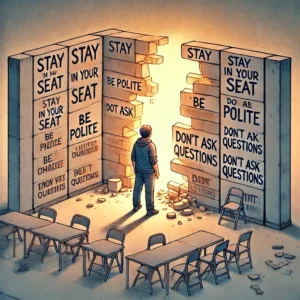“I have come to the frightening conclusion that I am the decisive element. It is my personal approach that creates the climate. It is my daily mood that makes the weather….In all situations, it is my response that decides whether a crisis is escalated or de-escalated, and a person is humanized or is dehumanized.”
— Johann Wolfgang von Goethe
Our work at McLaren Coaching is largely about developing coaches, whether they be professional coaches or “coach-style leaders” who work as managers. This blog post is about how you “show up” as a leader but reading it will affect all the areas of your life.
Why Should you Read this Blog Post?
Before we examine moods and moodiness, let’s be clear about one thing – your mood affects your employees in many and profound ways. Also, it seems many of us think we hide our moods well. We don’t. People are affected by your mood, even if you think it doesn’t show.
What are the prices you are paying for having varied, sometimes unpredictable and less useful moods?
- Lower Morale: Whether people are happy to come to work or not has a lot to do with how they feel about YOU. How they feel about you has a lot to do with how you are acting toward them – your mood states and behaviors.
- Loss of Trust: It is so important that your employees trust you. But they won’t if they don’t know what to expect from you from day to day. This makes for shaky and uncertain footing for those who are looking at you to lead.
- Loss of Approachability: One of the most common things I hear from leaders is “my people don’t come to me.” If that is true for you, consider how your mood state might be affecting this.
- Whether you are Achieving your Desired Outcomes: What do you want in the way of goals and deliverables? Meeting them requires teamwork and trust. Your moods affect the team’s ability to meet their goals.
- Employees may not Take Initiative: It can be scary for employees to do or try something new or beyond their regular tasks. They need to know that you will support them. Even if you think you are supporting them, when your moods are shifting and unpredictable and make you unapproachable (or scary), employees may not “stretch” themselves because they don’t know what kind of reaction they will get from you.
What is a “Mood?”
A mood is a seemingly intangible and internal experience you are having in any given moment. It encompasses an emotional and/or physical experience that you are having. You may be tired, annoyed, excited, happy, frustrated, or angry. Each of these is a feeling. And a feeling can create a mood. Moods are obvious through behavior and non-verbal cues such as tone of voice, facial expression and attitude.
The term “moodiness” refers to the changeability of your mood.
Let’s imagine there is a spectrum of moodiness that ranges from being neutral and unflappable and in control of your emotions and ways of being all the time – on the one end – to absolute unpredictability on the other. Where are you on this spectrum?
To be in control of your mood 100% of the time is not a real human ability. What you can do is cultivate a sense of awareness of yourself and knowledge of how you are affecting others.
There are many reasons one might be on the more unpredictable end of the spectrum and not in full control of their mood state all the time. These range from a hormonal or chemical imbalance to sleep issues to health aspects to a lack of awareness of self and how you are affecting others.
What is Your Mood?
Your moods are based on many factors. None of your moods is “wrong.” But it may not be useful in a particular situation, while very helpful in another. Screaming at a person who has made a mistake in your organization is not helpful; screaming at a potential attacker in an alleyway is.
What is your mood? Most people do not have a lot of awareness about their own mood states. Here are two ways to become more familiar:
1. Self-Observation:
- Feelings: Because a mood is in part a feeling, check in with your body a couple times a day. Ask yourself, “how do I feel right now?” Remember to start with your physical feelings. Are you tired? Do your neck muscles feel tense? Do you feel a tightness in your chest? Do you feel an uneasiness in your stomach? State that as your feeling: “I feel like my legs are shaky,” for example. Then try naming the emotion associated with the physical feeling. “I feel nervous.” Or, “I feel anxious” or “excited.”
- Thoughts: Moods also affect your thoughts so notice when your thoughts are becoming less productive, if you are internally judging other people or thinking about how hard things are. Become familiar with yourself and how your thoughts sound when you are in a non-productive mood.
2. Ask Other People: Feedback is an important part of leadership. Ask people how they experience you from day to day:
- What moods are most predominant?
- How comfortable do they feel approaching you?
- How moody do they feel that you are?
This can be uncomfortable, but it will teach you a lot.
You are in Control of your Mood State.
You have much more control over your mood than you might imagine. There are many places to intervene with yourself and cause a shift in how you are feeling and how you are acting.
Your moods are like dominoes. You know the game where you line them up and tip the first one which tips the next and the whole row of dominoes falls? If you get out of bed late or step on a Lego, that is the first domino. You feel grumpy or mad and you walk into the kitchen where someone says something to you and you take it wrong. The next domino falls. The situation escalates and the next experience of your day feels worse and goes worse because you are already in a grumpy mood. And so on as all the dominoes fall.
This is how we experience our moods. But it doesn’t have to be this way. You can create space between the dominoes. You do this by stopping yourself – noticing the problem. Here are some ideas once you notice your mood is not a useful one to bring to work:
- Walk away – go anywhere. Even for a couple minutes. It is particularly effective if you go outside and look up or take a short walk.
- Expend energy – go somewhere you can run or yell or throw something.
- Breathe – take several deep breaths.
- Close your eyes – this will change your physiological state. For bonus points, visualize a place that feels peaceful or joyful to you.
- Talk about it – find someone – a friend, spouse, whomever – and talk about how you feel. Don’t complain. Actually express your feelings.
- Write it down – write how you feel. Write quickly and get it all out. You could even burn it later.
Bottom Line: You are a leader. You are responsible for noticing your feelings. You are responsible for being in a state that facilitates your employees’ best work. Learn to notice your moods. Learn how they affect others. Learn to interrupt them and take responsibility for being in a space to be the most effective with the people you lead.
If you are a manager and you are interested in developing your coach-style leadership skills, or if you are a person interested in pursuing professional coaching as a career, we have recently opened registration for our next Transformative Coaching Essentials program, beginning in July 2024. Click here for more info and contact Cami to discuss!







